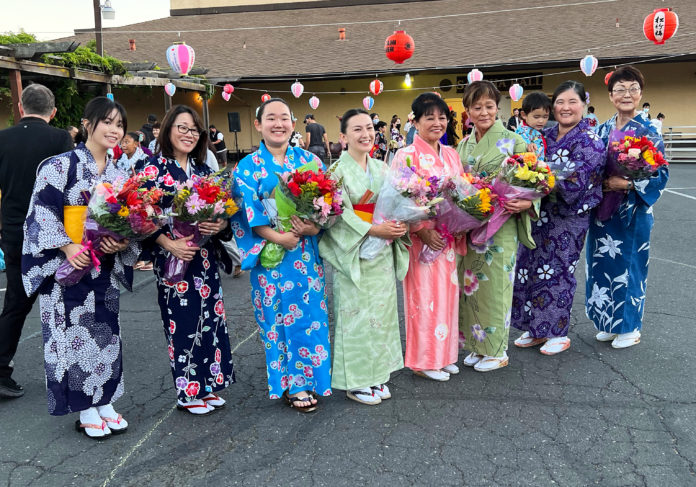Wearing a colorful Yukata, eating some Japanese food, and listening to music and singing from San Jose Chidori Band, are all parts of celebrating Obon at Southern Alameda County Buddhist Church in Union City. And of course, dancing with Obon Odori! Both joyous and solemn, the festival honors ancestors and departed loved ones. On the evening of Saturday, August 10, the community is invited to join the celebration, and on Sunday morning the church will hold a Hatsubon service for people who have passed away within the last year.
Karen Suyama has been dancing at Obon ever since her parents and grandparents took her to Berkeley Buddhist Church when she was growing up, and she has been an instructor at Southern Alameda County Buddhist Church ever since she moved to Fremont in the late 70s. She studied Buyou, a form of classical Japanese dance, but the simple dances she teaches for Obons are easy to pick up even by those with no dance background.
“Because maybe 75% of the dances are the same as the year before,” she says, “It makes it easy to get into the practices and the dances.” There are hundreds of Obon dances done at temples across Japan, ranging from traditional to modern. “There’s a couple of dances I think I’ve been doing since I started doing Obon. We’ve kept those on.”
One traditional and popular dance is Tanko Bushi, or the Coal Miner Dance, set to a song about mining coal in the mountains of Japan, with steps pantomiming shoveling coal and pushing a cart. By contrast, in Pokemon Ondo, the steps reflect cute gestures that might be taken by Pikachu or Squirtle.
Including the context helps people learn. “I try to find a background to the song to make it more meaningful for everybody,” Suyama says. “And hopefully that helps them to understand the dance and enjoy the story that goes along with it.
SACBC will try two new dances this year. One is Ee Janai Ka, choreographed by San Jose Taiko. “It’s not quite as simple as the other dances,” Suyama notes. “But that’s OK. Sometimes you have to make people think–and move!” It was more difficult for people to pick up at dance practices. “But they were having fun with it and I know they liked it, so that’s all that matters.”
The other new dance, Lantern Song, was commissioned by The Buddhist Churches of America (BCA) to commemorate the 125th anniversary in 2024. In 1899, two Buddhist ministers from Japan came to San Francisco to teach among Japanese immigrants who were missing the spiritual instruction they had back in their country of origin. This is regarded as the start to what would grow into BCA.
Suyama reflects, “I like the dancing because it helps to remind me that this has been done for a long time. To honor our ancestors. It’s pretty meaningful to me because my grandparents and parents were very instrumental in getting me into dance and becoming an instructor. They would always come out and cheer me on.” She adds with a laugh, “My grandmother used to always clap, so she would embarrass me.”
She continues, “I enjoy doing it every year. It helps to remember everybody who’s not here anymore. And that does include my parents, and grandparents, aunts and uncles, everybody.”
There are two more upcoming practices the week before Obon, held at the church in the Sangha Hall on Wednesday 8/7 and Thursday 8/8, both starting at 7pm. But you don’t need to practice to dance!
SACBC Obon
Saturday, Aug 10
5pm Food sales start
7pm Obon Odori
Southern Alameda County Buddhist Church
32975 Alvarado-Niles Rd., Union City
(510) 471-2581
www.sacbc.org




